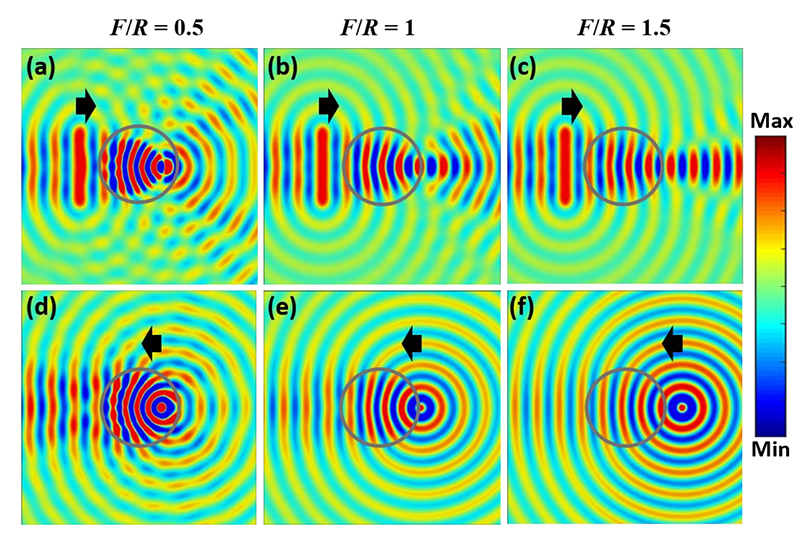 |

|
 |
Numerical simulations of the steady state response of the modified Luneburg Lens for flexural wave focusing and collimation.(Fig. 3 from the paper) |
|
There is widespread and sustained interest in controlling and manipulating structural waves for vibration-based energy harvesting, structural health monitoring, and medical diagnosis and therapy, including ultrasonic imaging, diagnosis and treatment.
A Luneburg lens can be used to improve these systems through its ability to focus and collimate waves. The Luneburg lens is a symmetric gradient-index lens with a refractive index that radially increases from the outer surface to the center. An ideal Luneburg lens should be easy to fabricate, and has broadband and omnidirectional characteristics, as well as a focal length that can be easily tuned. However, existing structural Luneburg lenses based on phononic crystals have difficulty achieving these requirements.
In Multi-Functional Variable Thickness Structure for Broadband and Omnidirectional Focusing and Collimation, ISR Postdoctoral Researcher Liuxian Zhao; Changquan Lai of Temasek Laboratories, Nanyang Technological University, Singapore; and Professor Miao Yu (ME/ISR) propose an alternative structural Luneburg lens which has a refractive index that varies smoothly with its radial distance as a result of a changing thickness. This simple lens design enables a continuous gradient of refractive index, which allows flexural wave propagation to be manipulated and overcomes limitations in existing wave manipulation devices.
Theoretical calculations, numerical simulations and experimental measurements of flexural wave propagation through the lens show that flexural wave focusing can be obtained inside, at the edge and outside of the variable thickness lens for different frequencies and propagation directions. Flexural wave collimation is demonstrated when a point source is placed at the respective focal points for each lens. Furthermore, the paper shows that the focusing property of the Luneburg lens enhances the performance of vibration-based energy harvesting, leading to a significant increase in harvested voltage compared to that obtained without focusing.
Related Articles:
Two papers by Yu and colleagues advance development of lenses and waveguides
Zhao, Yu, Horiuchi propose gradient index acoustic metamaterial Luneburg lens
$1.5M in NSF funding secured to improve solar energy conversion systems
Alireza Khaligh named IEEE ‘Featured Author'
Al-Obaid, Adomaitis publish renewable energy algorithm in Royal Society of Chemistry journal
Seven UMD Grand Challenges projects include ISR and MRC faculty
NSF funding for Khaligh, Han will further traction inverter development
Updates from Maryland Power Electronics Lab (MPEL)
Khaligh named Editor-in-Chief of IEEE Transactions on Transportation Electrification
Hybrid electric aircraft could benefit from active control of power trains
February 28, 2020
|

